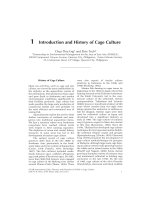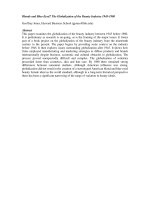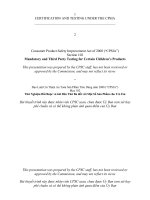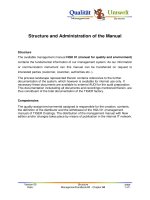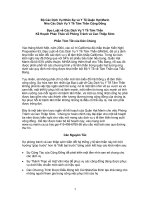Tài liệu Classifications and Scores of the Shoulder ppt
Bạn đang xem bản rút gọn của tài liệu. Xem và tải ngay bản đầy đủ của tài liệu tại đây (6.5 MB, 302 trang )
Peter Habermeyer ´ Petra Magosch ´ Sven Lichtenberg
Classifications and Scores of the Shoulder
Peter Habermeyer ´ Petra Magosch ´ Sven Lichtenberg
Classifications and Scores
of the Shoulder
12
Professor Dr. Peter Habermeyer
Dr. Petra Magosch
Dr. Sven Lichtenberg
ATOS Praxisklinik Heidelberg
Bismarckstraûe 9±15
69115 Heidelberg
Germany
ISBN-10 3-540-24350-X Springer Berlin Heidelberg New York
ISBN-13 978-3-540-24350-2 Springer Berlin Heidelberg New York
Library of Congress Control Number: 2005938553
This work is subject to copyright. All rights are reserved, whether the whole or part of the
material is concerned, specifically the rights of translation, reprinting, reuse of illustrations,
recitation, broadcasting, reproduction on microfilm or in any other way, and storage in
data banks. Duplication of this publication or parts thereof is permitted only under the
provisions of the German Copyright Law of September 9, 1965, in its current version, and
permission for use must always be obtained from Springer-Verlag. Violations are liable for
prosecution under the German Copyright Law.
Springer is a part of Springer Science+Business Media
springer.com
° Springer Berlin ´ Heidelberg 2006
Printed in Germany
The use of general descriptive names, registered names, trademarks, etc. in this publication
does not imply, even in the absence of a specific statement, that such names are exempt
from the relevant protective laws and regulations and therefore free for general use.
Editor: Gabriele M. Schræder, Heidelberg, Germany
Desk Editor: Irmela Bohn, Heidelberg, Germany
Production: LE-TeX Jelonek, Schmidt & Væckler GbR, Leipzig, Germany
Cover: Frido Steinen-Broo, eStudio Calamar, Spain
Typesetting: K +V Fotosatz GmbH, Beerfelden, Germany
Printed on acid-free paper 24/3100YL/Wa 5 4 3210
Upon opening this reference book you might be surprised to see that
enough classifications and scores concerning the shoulder joint exist to
fill an entire compendium ± and not even all of them are included. This
multitude alone illustrates why this book needed to be published. The
intention of the editors is to provide all those who are scientifically and
clinically engaged with the shoulder joint with a collection of original
research and an easy way to find desired information.
Classifications are categories that serve as a basis for establishing the
degree of severity and thus a prognosis. Treatment options and proce-
dures can then be planned. The task of scores is to evaluate the pursued
therapy and measure the outcome. Together with evidence-based medi-
cine, classifications and scores are measurable and reproducible tools
that help validate the quality of our medical work.
With regards to the content, we strictly followed the original articles
and original illustrations and did not add our own rating, interpretation
or evaluation. Only illustrations of bad quality were revised. The classi-
fications are topographically arranged. When important, we also added
classifications outside the border areas, i.e. in the field of radiology. The
criteria for inclusion in this compendium were publications of explora-
tive or representative studies and their clinical relevance.
We thank all authors for giving their permission to publish the classi-
fications and scores and are very pleased about their positive consent.
We appreciate any suggestions, ideas and criticism and ask for under-
standing from all those whose classifications could not be included in
this first edition.
We express our thanks to Springer and especially to Ms. Gabriele
Schræder and Ms. Irmela Bohn for their support of our project and the
layout of the manuscript.
Preface
We hope this compendium will be of great use and lead to further
studies.
Heidelberg, April 2006
On behalf of the editors: Prof. Dr. med. habil. Peter Habermeyer
VI Preface
1 Acromion/Spina Scapulae 1
1.1 The morphology of the acromion according to Bigliani 1
1.2 Classification of the acromial morphology on sagittal oblique
MRI according to Epstein 2
1.3 Types of os acromiale according to Liberson 4
1.4 Types of scapular notch according to Rengachary et al. 5
2 Subacromial space 7
2.1 Stages of outlet impingement according to Neer 7
2.2 Stages of impingement in athletes according to Jobe 8
3 Classifications of calcifying tendinitis of rotator cuff 9
3.1 Stages of calcifying tendinitis according to Uhthoff 9
3.2 Radiologic staging of calcifying tendinitis of the shoulder
joint according to Gårtner and Heyer 11
3.3 Radiological classification of calcific deposit according
to Bosworth 12
3.4 Classification of radiological morphology of calcifying
tendinitis of the rotator cuff according to Mol et al. 12
4 Classifications of frozen shoulder 13
4.1 Classification of frozen shoulder according to Lundberg 13
4.2 Stages of frozen shoulder according to Reeves 13
4.3 Arthroscopic stages of adhesive capsulitis according
to Neviaser 14
5 Classifications of rotator cuff 17
5.1 Classifications of rotator cuff tears according to Patte 17
5.2 Topography of rotator cuff tear in the sagittal plane
according to Habermeyer 19
Contents
5.3 Arthroscopic classification of partial-thickness rotator cuff
tears according to Ellman 20
5.4 Arthroscopic classification of rotator cuff lesions according
to Snyder (the Southern California Orthopedic Institute (SCOI)
rotator cuff classification system) 22
5.5 Classification of complete rotator cuff tears
according to Cofield 23
5.6 Classification of complete rotator cuff tears
according to Bateman 23
5.7 Classification of the extent of rotator cuff tears
according to Patte 24
5.8 Patterns of full-thickness rotator cuff tears
according to Ellman and Gartsman 26
5.9 Classification of subscapularis tendon tears
according to Fox and Romeo 28
5.10 Classification of tendon retraction in the frontal plane
according to Patte 29
5.11 Classification of supraspinatus muscle atrophy in MRI
according to Thomazeau 29
5.12 Classification of supraspinatus muscle atrophy in MRI
according to Zanetti 31
5.13 Classification of fatty muscle degeneration in cuff ruptures
using CT-scan according to Goutallier et al. [49] 33
6 Classifications of pathology of long head of the biceps
tendon 35
6.1 Variants of the origin of the long head of the biceps from
the scapula and glenoid labrum according
to Vangsness et al. 35
6.2 Classification of SLAP-Lesions (superior labrum, anterior
to posterior lesion) according to Snyder 36
6.3 Classification of SLAP lesion according to Maffet et al. 38
6.4 Subtypes of SLAP II lesions according to Morgan 39
6.5 Topographic classification of LHB-lesions 40
6.6 Classification of biceps tendon disorders
according to Yamaguchi and Bindra 41
VIII Contents
6.7 Histological changes of the long head of the biceps
tendon according to Murthi et al. 42
6.8 Classification of subluxation of the long head of the
biceps tendon according to Walch 42
6.9 Classification of dislocation of the long head of the
biceps tendon according to Walch 43
6.10 Classification of ªhiddenº rotator interval lesions
according to Bennett 45
6.11 Classification of pulley lesions according to
Habermeyer et al. 46
7 Classifications of instability 49
7.1 Classification of scapular dyskinesis according to Kibler
and McMullen 49
7.2 Types of variable topographical relationship of the
glenohumeral ligaments to the synovial recesses
(types of arrangement of the synovial recesses)
according to DePalma 50
7.3 Variations of glenohumeral ligaments according
to Gohlke et al. 53
7.4 Anatomical variations of the glenohumeral ligaments
according to Morgan et al. 56
7.5 Classification of instability according to Silliman
and Hawkins 57
7.6 Grading of glenohumeral translation
according to Hawkins et al. 58
7.7 Classification of recurrent instability
according to Neer and Foster 59
7.8 Classification of shoulder instability according to
Matsen et al. 60
7.9 Classification of shoulder instability
according to Gerber et al. 61
7.10 Classification of shoulder instability
according to Bayley et al. 71
7.11 Types of lesions of anterior inferior shoulder instability
according to Habermeyer 73
a Contents IX
7.12 Classification of posterior shoulder instability
according to Ramsey and Klimkiewicz 76
7.13 Classification of glenoid rim lesions
according to Bigliani et al. 79
7.14 Arthroscopic classification of Hill-Sachs lesions
according to Calandra et al. 79
7.15 Classification of significant Hill-Sachs lesions
according to Burkhart and De Beer 80
7.16 Stages of evolution of lesions of the labrum-ligament
complex in posttraumatic anterior shoulder instability
according to Gleyze and Habermeyer 82
7.17 Classification shoulder injury/dysfunction (impingement and
instability) in the overhand or throwing athlete
according to Kvitne et al. and Jobe et al. 84
7.18 Arthroscopic classification of labro-ligamentous lesions
associated with traumatic anterior chronic instability
according to Boileau et al. 87
8 Acromioclavicular joint 91
8.1 State of AC-joint space and SC-joint space
according to De Palma 91
8.2 Classification of AC-joint dislocation
according to Tossy et al. 93
8.3 Classification of AC-joint injuries according to Allman 94
8.4 Classification of AC-joint injury
according to Rockwood et al. 96
9 Sternoclavicular joint 103
9.1 Classification of SC-joint injury according to Allman 103
10 Classifications of fractures of the clavicle 105
10.1 Classification of fractures of the clavicle
according to Allman 105
10.2 Classification of fractures of the clavicle
according to Neer 106
10.3 Classification of fractures of the clavicle
according to Jåger and Breitner 109
X Contents
10.4 Classification of clavicular fractures according to Craig 111
10.5 Classification of fractures of the clavicle in adult
according to Robinson 114
10.6 Classification of nonunion of clavicular fractures
according to Neer 117
10.7 Classification of epiphyseal fractures of the proximal
end of the clavicle according to Rockwood and Wirth 117
11 Classifications of proximal humeral fractures 119
11.1 Classification of proximal humeral fractures
according to Neer 119
11.2 AO-Classification of proximal humeral fractures 131
11.3 Classification of proximal humeral fractures
according to Habermeyer 138
11.4 Surgical classification of sequelae of proximal humerus
fracture according to Boileau et al. 140
11.5 Classification of periprosthetic humeral fractures
according to Wright and Cofield 142
12 Classifications of scapular fractures 143
12.1 Classification of scapula fractures according to Euler
and Rçedi 143
12.2 Classification of scapular fractures according to DeCloux
and Lemerle 146
12.3 Classification of scapular fractures
according to Zdravkovic and Damholt 146
12.4 Classification of intraarticular scapular fractures
according to Ideberg et al. 147
12.5 Classification of fractures of the glenoid cavity
according to Goss 148
12.6 Classification of glenoid neck fractures
according to Goss 150
12.7 Types of traumatic ring/strut disruption of the superior
shoulder suspensory complex according to Goss 151
13 Classifications of osteoarthritis of the shoulder 155
13.1 Grading of chondromalacia according to Outerbridge 155
a Contents XI
13.2 Classification of glenoid morphology in primary gleno-
humeral osteoarthritis according to Walch et al. 155
13.3 Assessment of humeral head subluxation
according to Walch et al. 157
13.4 Classification of vertical glenoid morphology
according to Habermeyer 157
13.5 Classification of osteoarthritis with massive rotator cuff
tears according to Favard et al. 159
13.6 Classification of cuff tear arthropathy
according to Seebauer et al. 160
13.7 Classification of cuff tear arthropathy
according to Hamada et al. 161
13.8 Classification of glenoid erosion in glenohumeral
osteoarthritis with massive rupture of the cuff
according to Sirveaux et al. 162
13.9 Radiographic classification of dislocation arthropathy
of the shoulder according to Samilson and Prieto 163
14 Classifications of necrosis of the humeral head 165
14.1 Classification of osteonecrosis of bone
according to Cruess 165
14.2 Classification of avascular necrosis of the humeral
head according to Neer 167
14.3 Classification of the extent of osteonecrosis of the humeral
head according to Hattrup and Cofield 169
15 Classifications for rheumatoid arthritis 171
15.1 Variations in involvement in rheumatoid arthritis 171
15.2 Staging of glenoid wear in rheumatoid arthritis
according to Lvigne and Franceschi 173
15.3 Staging of humeral head wear in rheumatoid arthritis
according to Lvigne and Franceschi 173
15.4 Radiological classification of rheumatoid arthritis
according to Lvigne and Franceschi 174
15.5 Radiologic classification of rheumatoid arthritis
according to Larsen, Dale, Eek 176
XII Contents
16 Classification of septic arthritis 179
16.1 Stages of joint infection according to Gåchter
and Stutz et al. 179
16.2 Proposed classification system of septic arthritis
according to Tan et al. 179
17 Classification of neoplasms 183
17.1 The system for the surgical staging of musculoskeletal
sarcoma according to Enneking et al. 183
18 Classifications in shoulder arthroplasty 191
18.1 Radiographic assessment of radiolucent lines
of the humeral component according to Sperling et al. 191
18.2 Radiographic assessment of radiolucent lines
of the glenoid component according to Sperling et al. 192
18.3 Radiographic assessment of radiolucent lines
of the cemented glenoid component
according to Mol et al. 193
18.4 Radiographic assessment of radiolucent lines
of the glenoid component according to Franklin et al. 194
18.5 Radiographic assessment of radiolucent lines
of the cemented glenoid component
according to Wilde et al. 194
18.6 Classification of bone defects of the scapular notch
for inverse shoulder arthroplasty according to Sirveaux 195
18.7 Classification of glenoid bone deficiencies after glenoid
component removal according to Antuna et al. 195
18.8 Classification of heterotopic bone formation
following total shoulder arthroplasty
according to Kjaersgaard-Andersen et al. 196
19 Scores 199
19.1 Constant-Murley Score 199
19.1.1 Normative age- and sex-specific Constant Score
according to Gerber et al. 202
19.1.2 Normative age- and gender-related Constant Score
according to Katolik et al. 204
a Contents XIII
19.1.3 Valuation of the Constant Score according to Boehm 204
19.2 Questionnaire based on the Constant-Murley Score
for patient self-evaluation of shoulder function
according to Boehm 205
19.3 UCLA shoulder rating 213
19.4 DASH (Disabilities of the Arm, Shoulder and Hand)
Questionnaires 214
19.4.1 The DASH Questionnaire 220
19.4.2 The Quick DASH Questionnaire 220
19.4.3 Scoring the DASH 220
19.5 The ASES (American Shoulder and Elbow Surgeons)
Score 222
19.6 Simple shoulder test 228
19.7 Short form 36 (SF-36) 233
19.8 VAS 248
19.9 Shoulder pain and disability index (SPADI) 249
19.10 Self-administered questionnaire for assessment
of symptoms and function of the shoulder
according to L'Insalata et al. 252
19.11 ªOxfordº questionnaire on the perceptions of patients
about shoulder surgery 259
19.12 Oxford shoulder instability questionnaire 262
19.13 Rowe Score 265
19.14 The modified Rowe Score according to Jobe et al. 266
19.15 The Western Ontario shoulder instability index (WOSI) 267
19.16 The Walch-Duplay Score for instability of the shoulder 270
19.17 The Western Ontario rotator cuff index (WORC) 270
19.18 The rotator cuff quality-of-life measure (RC-QOL) 274
19.19 The Western Ontario osteoarthritis of the shoulder index
(WOOS) 278
References 283
Sachverzeichnis 293
XIV Contents
The following footnotes apply to the entire text:
** Validated only by an explorative study
** Validated by an explorative and a representative study
Special note
1.1 The morphology of the acromion
according to Bigliani [1, 9, 11]*
One hundred and forty shoulders in 71 cadavers (52% male, 48% fe-
male) were studied to determine the shape of the acromion and its rela-
tionship to full-thickness tears in the rotator cuff. The average age of
the cadavers was 74.4 years (range, 51±97 years).
The overall incidence of full-thickness rotator cuff tears in this el-
derly population was 34%. In this series 24% of rotator cuffs had full-
thickness rotator cuff tears.
Lateral radiographs were performed in the longitudinal axis so that
the anterior slope of the acromion could be measured.
Three distinct types of acromions were identified (Fig. 1 a±c):
n Type I: flat (17.1%)
Angle of anterior slope: 13.18
Full-thickness rotator cuff tears: 3.0%
n Type II: curved (42.9%)
Angle of anterior slope: 29.98
Full-thickness rotator cuff tears: 24.2%
n Type III: hooked (39.3%)
Angle of anterior slope: 26.98
Full-thickness rotator cuff tears: 69.8%
In addition, anterior acromial spur formations were noted in 14.2% of
the series overall, but 70% were present in patients with rotator cuff
tears. It is important to distinguish between spurs, which are probably
acquired, and variations in the native architecture of the acromion.
Acromion/spina scapulae
1
1.2 Classification of the acromial morphology
on sagittal oblique MRI according to Epstein [36]*
Acromion shape was classified as (Fig. 2):
n Type 1: flat
n Type 2: smoothly curved
n Type 3:hooked
Sagittal oblique T2-weigthed or fast spin-echo images were obtained at
a908 angle to the long axis of the supraspinatus tendon as determined
with an axial localizing image.
The acromions were classified according to their appearance on the
image obtained just lateral to the acromioclavicular joint. This image
consistently demonstrated the greatest longitudinal length of the acro-
mion, and was at or just beyond the tip of the coracoid. Occasionally, it
was difficult to differentiate between type 2 and type 3 acromions. If
the apex of the curve or hook was within the middle one-third of the
acromion, it was considered a type 2 acromion. If the apex of the curve
2 1 Acromion/spina scapulae
Fig. 1. A Type-I acromion: flat.
B Type-II acromion: curved.
C Type-III acromion: hooked
A
B
C
a 1.2 Classification of the acromial morphology on sagittal oblique MRI 3
A A
A
Fig. 2. a Classification of acromial shape in MRI. Illustration depicts the three acro-
mial shapes: flat (type 1); smoothly curved (type 2); and hooked (type 3). b Sagittal
oblique MRI demonstrates a flat (type-1) acromion. c Sagittal oblique MRI demon-
strates a smoothly curved (type-2) acromion. d Sagittal oblique MRI demonstrates a
hooked (type-3) acromion. A anterior, P posterior. (From [36])
a
b
c
d
or hook was in the anterior one-third of the acromion, it was classified
as a type 3 acromion.
1.3 Types of os acromiale according
to Liberson [77, 90]*
Liberson [77] reviewed the roentgenograms of 1800 shoulder girdles,
chosen at random, and found 21 typical and 4 atypical cases of os acro-
miale, for an incidence of os acromiale of 1.4%. The lesion is bilateral
in 62% of patients.
Definition of os acromiale: when there is a failure of union of any
one of the ossifications centres to its neighbour, the resulting separate
bone is an os acromiale.
Four different types of unfused acromia were described (Fig. 3):
n The most common nonunion is between the meso-acromion and the
meta-acromion (typical os acromiale)
n Nonunion between the pre-acromion and meso-acromion (atypical)
n Nonunion between pre-acromion and meso-acromion as well as
meso-acromion and meta-acromion (atypical)
n Nonunion between pre-acromion and meso-acromion, and pre-acro-
mion and meso-acromion as well as meta-acromion and basi-acro-
mion (atypical)
4 1 Acromion/spina scapulae
Fig. 3. Types of os acromiale according to Liberson [77, 90]
1.4 Types of scapular notch according
to Rengachary et al. [110]*
Rengachary et al. [110] observed six basic types of supracapular notch
in 211 cadaveric adult scapulae (Fig. 4):
n Type I (no notch): The entire superior border of the scapula showed
a wide depression from the medial superior angle of the scapula to
the base of the coracoid process.
Relative frequency 8%.
n Type II: This type showed a wide, blunted ªvº-shaped notch occupy-
ing nearly a third of the superior border of the scapula. The widest
point in the notch was along the superior border of the scapula.
Relative frequency 31%.
n Type III: The notch was symmetrical and ªUº-shaped with nearly
parallel lateral margins.
Relative frequency 48%.
a 1.4 Types of scapular notch according to Rengachary et al. 5
Fig. 4. Types of scapular notch
n Type IV: The notch was very small and ªvº-shaped. Frequently a
shallow groove representing the bony impression by the suprascapu-
lar nerve was visible adjacent to the notch.
Relative frequency 3%.
n Type V: This type was very similar to Type III (U-shaped), with par-
tial ossification of the medial part of the ligament resulting in a
notch with the minimal diameter along the superior border of the
scapula.
Relative frequency 6%.
n Type VI: The ligament was completely ossified, resulting in a bony
foramen of variable size located just inferomedial to the base of the
coracoid process.
Relative frequency 4%.
Although the majority of the scapulae were easily classified into the
six types defined above, occasional transitional types did occur. In addi-
tion, there were many minor variations within a given type.
Transitions tended to occur more frequently between Types II, III
and IV.
6 1 Acromion/spina scapulae
2.1 Stages of outlet impingement according
to Neer [97] *
Stage I: edema and hemorrhage
n Characteristically caused by overuse with the arm above the
horizontal
n Typical age: <25 years
n Differential diagnosis: subluxation, AC-arthritis
n Clinical course: reversible
n Treatment: conservative
Stage II: fibrosis and tendinitis
n Typical age: 25±40 years
n Differential diagnosis: frozen shoulder, calcifying tendinitis
n Clinical course: recurrent pain with activity
n Treatment: consider bursectomy; CA ligament division
Stage III: bone spurs and tendon rupture
n Typical age: > 40 years
n Differential diagnosis: cervical radiculitis; neoplasm
n Clinical course: progressive disability
n Treatment: anterior acromioplasty, rotator cuff repair
Subacromial space
2
2.2 Stages of impingement in athletes according
to Jobe [65]
n Stage 1:
Tendinitis, usually of the supraspinatus or the long head of the
biceps
n Stage 2:
Fibre dissociation in the tendon
n Stage 3:
Rotator cuff tear less than 1 cm
n Stage 4:
Rotator cuff tear 1 cm and more
8 2 Subacromial space
3.1 Stages of calcifying tendinitis according
to Uhthoff [130] *
The authors discriminate between degenerative calcification and calcify-
ing tendinosis. The incidence of calcification increases with age in cases
of degenerative calcification, whereas it peaks during the fifth decade in
cases of calcifying tendinits. Moreover, degenerative diseases never ex-
hibit a potential for self-healing. Futhermore, the histologic and ultra-
structural features of degenerative calcification and calcifying tendinosis
are quite different.
The authors proposed that the evolution of the disease can be di-
vided into three distinct stages (Fig. 5):
1. Precalcific stage:
The site of predilection for calcification undergoes fibrocartilaginous
transformation. This metaplasia of tendocytes into chondrocytes is ac-
companied by metachromasia, indicative of the elaboration of proteo-
glycan.
2. Calcific stage:
The calcific stage is subdivided into
± The formative phase
During the formative phase, calcium crystals are deposited primarily
in matrix vesicles, which coalesce to form large foci of calcification.
If the patient undergoes surgery during this stage, the deposit ap-
pears chalklike and must be scooped out. The fibrocartilaginous sep-
ta between the foci of calcification are generally devoid of vascular
channels. They do not consistently stain positively for type II col-
lagen, which is known to be a component of fibrocartilage. These
fibrocartilaginous septa are gradually eroded by enlarging deposits.
Classifications of calcifying tendinitis
of rotator cuff
3
Pain is chronic or even absent.
Radiologically, the deposit is dense, well defined, and homogenous.
± The resting phase
During the resting phase, fibrocollagenous tissue borders the foci of
calcification. The presence of this tissue indicates that deposition of
calcium at that site is terminated.
± The resorptive phase
During the resorptive phase, after a variable period of inactivity of
the desease process, spontaneous resorption of calcium is heralded
by the appearance of thin-walled vascular channels at the periphery
of the deposit. Soon thereafter, the deposit is surrounded by macro-
phages and multinucleated giant cells that phagocytose and remove
the calcium. If an operation is performed during this stage, the calci-
fic deposit contains a thick, creamy or toothpastelike material that is
often under pressure.
Characterized by acute pain.
Radiologically, the deposit is fluffy, cloudlike, ill-defined, and irregu-
lar in density.
10 3 Classifications of calcifying tendinitis of rotator cuff
Fig. 5. The progressive stages of calcifying tendinitis
Rupture of the calcific deposit into the bursa can occur only during the
resoptive phase, because of the toothpaste-like or creamy consistency.
Radiographs show a crescentic radiodensity overlying the deposit.
3. Postcalcific stage:
Simulatneously with the resorption of calcium, granulation tissue con-
taining young fibroblasts and new vascular channels begins to remodel
the space occupied by calcium. These sites stain positively for type III
collagen. As the scar matures, fibroblasts and collagen eventually align
along the longitudinal axis of the tendon. During this remodelling pro-
cess, type III collagen is replaced by type I collagen.
It is important to note that not all foci of calcification in a given pa-
tient are in the same phase of evolution. In general, however, one phase
predominates. The morphologic aspect of an individual deposit can vary
from fibrocartilagenous tissue to foreign body-like granulomatous tis-
sue.
3.2 Radiologic staging of calcifying tendinitis
of the shoulder joint according
to Gårtner and Heyer [43] * (Fig. 6)
Type I
± The calcific deposit is clearly circumscribed and has a dense appear-
ance
± Formative phase
Type II: hybrid type
± Clearly circumscribed and translucent, cloudy and dense
± Assessment of stage is possible by performing a second X-ray exami-
nation after 6 to 12 weeks
Type III
± Cloudy and translucent appearance without clear circumscription
± Resorptive phase
a 3.2 Radiologic staging of calcifying tendinitis of the shoulder joint 11

